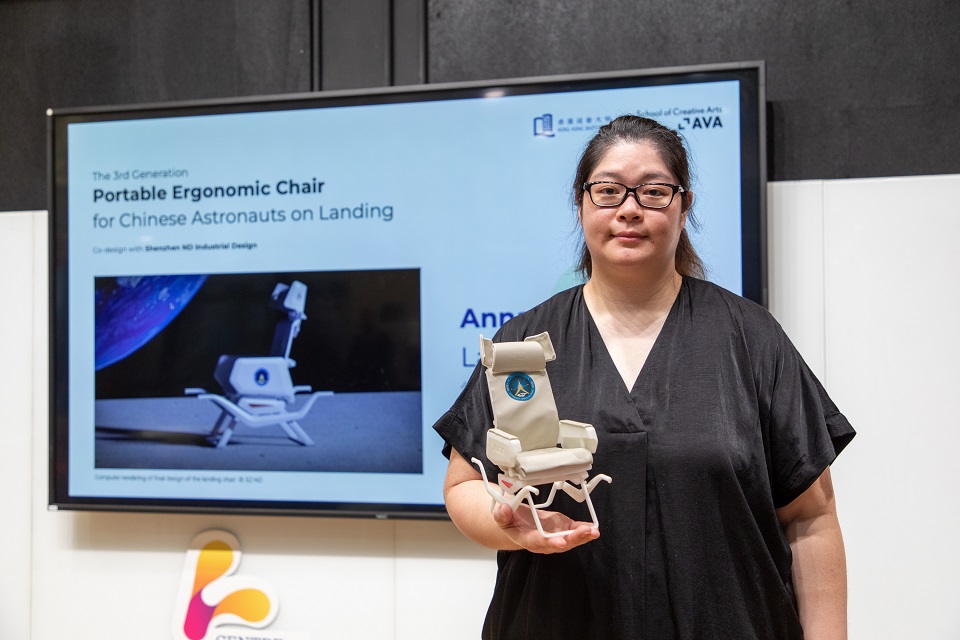Discover HKBU
Contributing to national space missions with innovative design
23 Nov 2022


Have you ever felt off-balance or nauseous after riding a roller coaster? Astronauts often feel something similar, and even more intensely, when they return to Earth from space due to the changes in their cardiovascular system caused by prolonged exposure to microgravity.
The weightlessness in space alters the bodies of astronauts, in particular their bones and muscle strength. Once they land after a space mission, their bodies start readjusting to Earth’s gravity, but it takes time. To provide immediate support to astronauts upon their re-arrival on Earth, Ms Anna Qin, Assistant Professor of the Academy of Visual Arts, collaborated with Shenzhen ND Industrial Design Co. Limited for the third time to design landing chairs for use by crews of China’s Shenzhou space missions.
Helping astronauts readjust to Earth’s gravity
Since 2013, Ms Qin and her design team have collaborated with experts from the Astronaut Center of China (ACC) to develop different models of the landing chair, which is one of the key tools for astronauts landing on Earth from spaceflights. It provides them with full-body support after their bodies, including bone density and muscle strength, have been affected or weakened by long periods of weightlessness.
One of the challenges in the design of the chair is that it has to be lightweight and portable. Ms Qin says: “When a spacecraft lands, the staff pre-positioned at the site have to immediately carry the landing chair to the exact landing location and help the astronauts out of the spacecraft. Therefore, the first model of our chair was designed to fold inside itself, like a suitcase, for easier transportation.”
Ergonomics was also incorporated in the design to ensure the chair can provide good support and comfort for the astronauts as they rest, move about and adapt to Earth’s gravity. In addition, the team infused artistic value into the design to highlight the significance of the nation’s space programme. “We hoped to integrate the concept of space exploration and a sense of ceremony, therefore our design blended characteristics of a space capsule with elements of an ancient Chinese sedan chair,” Ms Qin says.
The first model of the landing chair was used by the crew of the Shenzhou-10 mission, with an improved version used for Shenzhou-11 and Shenzhou-12. The third and latest model of the chair offers enhanced support and a recline feature with an adjustable backrest. It was used by three astronauts of the Shenzhou-13 mission who landed on 16 April this year. Ms Qin and her team will continue to work closely with the ACC and the astronauts of each mission to further optimise the design. “We will explore adding sensors to the chairs that can monitor and collect data from the astronauts about their levels of comfort, so we can further refine and improve our design,” she says.
Combining design with engineering to solve challenges
The landing chair illustrates how innovative design can solve real-world problems – something that Ms Qin has always sought to achieve, applying human-centred design approaches to develop products to address the challenges of today’s world.
After completing a Bachelor’s degree in Product Design at Central Saint Martins at the University of the Arts London, Ms Qin completed a Master’s degree in Biomedical Engineering at The Chinese University of Hong Kong. Drawing insights from product design and biomedical engineering, she participated in the design of assistive tools in the healthcare and medical field, including an exoskeleton for rehabilitating people with paralysis, wearable devices for tracking neck and spinal activity, as well as smart shoes for the elderly.
Joining HKBU in 2021, Ms Qin appreciates the opportunities offered by the University for interdisciplinary research collaborations. She is now working with researchers at the School of Chinese Medicine on a subcutaneous injector design for outer space applications, with a needle-free design that can reduce the amount of junk in space. “I hope to further contribute my designs to the nation’s space programme. It will be a dream come true,” she says.